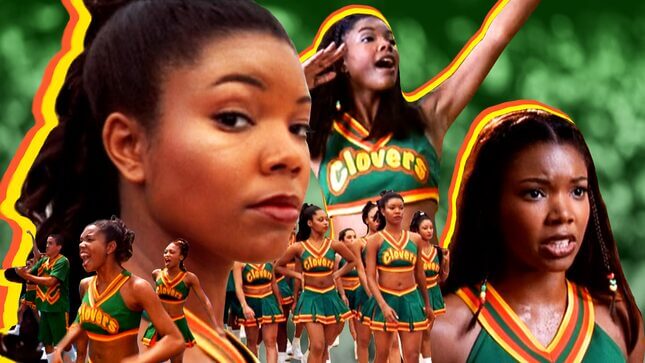
Graphic: Elena Scotti (Screenshots via Universal Pictures)
Twenty years ago, a women-led film packed with somersaults, splits, jumping jacks, and aerial cartwheels became the breakout hit of the summer, bringing in a worldwide total of $90 million from an $11 million budget. Bring It On was released during the final week of August when blockbusters were tapering to an end, and it could be said that little was expected of this production set in the rigorous world of competitive cheerleading. It wouldn’t fail, but neither was there any expectation that this would be all anyone would talk about once school was in session and 20 years after that. This little wonder, perfectly named, would make household and cult names of its leads (Kirsten Dunst and Gabrielle Union) while simultaneously shaping Halloween squads for the next couple of decades. In Hollywood, this is the kind of film that would have positioned Dunst as the one viewers would quote and young girls would idolize, but it’s Union whose supporting role took on supernova status, making her turn as Isis, captain of the East Compton Clovers a cultural touchstone for Black girls in sports and Black femmes who slay.
In the contemporary era of packaging wellness and sisterhood into witty one-liners that are often taken for granted, phrases like Black Girl Magic, Black Girl Joy, and Black Excellence are well-meaning as affirmations, but they say nothing about the work required to embody these realities, the responsibility to project effortless goodness. And yet they’ve become so synonymous with the language used to celebrate Black women, taking away any nuance and leaving little space to truly appreciate the perseverance and craft of those we are applauding. Union was 27 when she starred in Bring It On, and though pushing 30, she had spent most of her career playing a teenager, different in every instance, but with a familiar drive and caustic wit. Her ability to seamlessly morph into someone years younger regularly makes the rounds online with fans chiming in with the well-known “Black Don’t Crack” quip, a cute mantra which makes the reality far less sinister—that as one of the few visible Black women working in Hollywood, little opportunity was available for Union to showcase anything more than teenage angst.
-

-

-

-

-

-

-

-

-

-

-

-

-

-

-

-

-

-

-

-

-

-

-

-

-

-

-

-

-

-

-

-

-

-

-

-

-

-

-

-








































